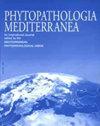Ceratocystis ficicola causing a serious disease of Ficus carica in Greece
IF 1.9
3区 农林科学
Q2 AGRONOMY
引用次数: 7
Abstract
Ceratocystis ficicola causes vascular wilt of fig trees in Japan, invading root systems and the main stems eventually leading to tree death. In surveys from 2018 to 2020 in fig orchards in Greece, this fungus was detected in two separated regions. The fungus was consistently isolated from infected wood and from rhizosphere soil. The isolates were identified based on multi-locus phylogenetic analyses of rpb2, bt1 and tef1 gene regions and detailed morphological characteristics, including comparisons with an ex-type isolate of C. ficicola from Japan. The pathogenicity of Greek isolates was proven on Ficus carica and F. benjamina plants. Ceratocystis ficicola is a soil-borne pathogen, and the occurrence of vascular wilt outbreaks suggest that the pathogen spreads within and between orchards with infested soil and wood debris during ploughing. The pathogen is also spreading in Greece with infected propagation material. This is the first detailed report of C. ficicola outside Japan, and there is concern over potential spread of the pathogen to other Mediterranean countries, where approx. 70% of the world fig production occurs.Ceratocystis ficicola在希腊引发严重的无花果病
在日本,Ceratocystis ficicola会导致无花果树枯萎,侵入根系和主茎,最终导致树木死亡。在2018年至2020年对希腊无花果园的调查中,在两个不同的地区发现了这种真菌。真菌一直是从受感染的木材和根际土壤中分离出来的。根据rpb2、bt1和tef1基因区的多基因座系统发育分析和详细的形态学特征,包括与日本的一个假丝酵母前型分离株的比较,鉴定了这些分离株。希腊分离株的致病性已被证实在无花果和本杰明上。Ceratocystis ficicola是一种土壤传播的病原体,枯萎病爆发的发生表明,该病原体在犁耕过程中在土壤和木屑受到感染的果园内和果园之间传播。这种病原体也随着受感染的繁殖材料在希腊传播。这是在日本以外首次对C.ficicola进行详细报道,人们担心这种病原体可能会传播到其他地中海国家,那里大约有世界70%的无花果生产。
本文章由计算机程序翻译,如有差异,请以英文原文为准。
求助全文
约1分钟内获得全文
求助全文
来源期刊

Phytopathologia Mediterranea
生物-植物科学
CiteScore
4.40
自引率
8.30%
发文量
28
审稿时长
6-12 weeks
期刊介绍:
Phytopathologia Mediterranea is an international journal edited by the Mediterranean Phytopathological Union. The journal’s mission is the promotion of plant health for Mediterranean crops, climate and regions, safe food production, and the transfer of new knowledge on plant diseases and their sustainable management.
The journal deals with all areas of plant pathology, including etiology, epidemiology, disease control, biochemical and physiological aspects, and utilization of molecular technologies. All types of plant pathogens are covered, including fungi, oomycetes, nematodes, protozoa, bacteria, phytoplasmas, viruses, and viroids. The journal also gives a special attention to research on mycotoxins, biological and integrated management of plant diseases, and the use of natural substances in disease and weed control. The journal focuses on pathology of Mediterranean crops grown throughout the world.
The Editorial Board of Phytopathologia Mediterranea has recently been reorganised, under two Editors-in-Chief and with an increased number of editors.
 求助内容:
求助内容: 应助结果提醒方式:
应助结果提醒方式:


